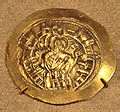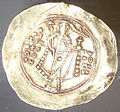|
The Byzantine Empire was a very powerful, yet mostly benign empire that created stability to Europe in a time known for its lawlessness and instability. The Byzantine Empire is responsible for many great things, especially the establishment of a currency system. Today, when our currency is created more for function than form, it is hard not to pay homage to the beautifully designed coins of the Byzantine Era.

Byzantine Gold Coins:
The denomination of Byzantine gold coins followed on from those of the late Roman Empire, before evolving. They include:
solidus
nomisma
semissis
hyperpyron
The look of the Byzantine gold coin was taken from the gold coins of the Roman Empire. The Romans put a lot of artistry into their coins, but the Byzantines took it even farther when they designed their uniquely brilliant coins. Even today there is a lot of interest in collecting reproductions of these fabulous coins. These coins were originally referred to as "histamenon nomisma" and are among the most sought after coins in collectors' circles.

CONOB
The abbreviation CONOB can be found usually in the exergue on the reverse of many gold coins of Byzantium.
CONOB. Constantinopoli obryzum. The solidus weighed 1/72 of the Roman pound. "OB" was both an abbreviation for the word obryzum, which means refined or pure gold, and is the Greek numeral 72. Thus the exergue CONOB coin may be read "Constantinople, 1/72 pound pure gold.
The symbolism of Jovian's solidus pictured above and below provides a wonderful microcosm of religious and political dominance: The emperor-general holding the Standard of Christ while a bound pagan captive cowers at his feet.
Despite the tremendous violent upheaval of this period the Byzantine Emperors managed to maintain a consistent purity to their gold coinage of .95 to .98 fineness. It was perhaps the greatest tribute to the power of Constantinople.
Designed in the shape of a "C," the odd design does not detract a bit from the beauty of the coin. It actually improves their look. One side shows the face of Jesus Christ, while the other has the image of the Byzantine Emperor. This is thought to have created the impression that the law was governed by both the divine and secular orders. We can learn a lot of the ideologies and conventional wisdom during the Byzantine Empire. This is what makes these coins so highly collectible. Just being able to examine one of these coins is an experience.
Byzantine coins are one of the most challenging and complex series to collect. Bronze issues, most of which are folles or 40 nummia pieces and divisions of that denomination, are frequently crudely struck, often over previous issues. By far the most extensive part of this thousand-year coinage series are gold solidi and their successors, which tend to sell at reasonable prices unless the issue is rare or unusual in some way.
There are relatively few silver issues because the Empire did not have a reliable source of silver production. During the Late Empire the gold coinage was debased by adding silver, and after more than a thousand years since the end of the Greek electrum coinage, that alloy reappeared as a significant numismatic metal.
|

![]()

